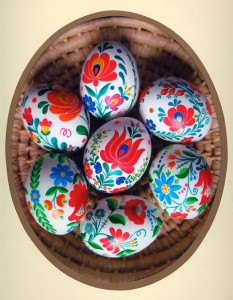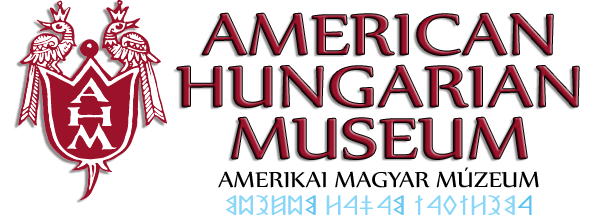HÍMESTOJÁS
Hungarian Decorated Easter Eggs

The cult of the decorated egg is one of the most ancient religious customs of humanity, and goes back thousands of years. The egg plays a significant role in the story of creation for many people. It represents the secret of eternal life condensed in a small enclosed and perfect geometrical form. Inside of the protective white mass is the mysterious gold, the Secret of secrets, the sprout. Doesn’t the gold inside the egg represent a drop of the creative power of the sun, which stands above all?
The egg is the ancient symbol of spring in the religion of numerous people. As the carrier of life it represents the past and the future. The egg is not only the symbol of creation but also of life, rebirth, resurrection, and above all fertility. The Hungarian custom of dousing women with water – locsolás Easter Monday, combined with presenting the symbol of creation, the magical hímestojás, is an ancient fertility ritual, and was taken very seriously.
The symbolism of the Hungarian decorated egg reaches back to pre-Christianity. Even after Hungarians converted to Roman Catholicism in the 10th century, their egg designs, contrary to neighboring people, preserved their original meaning and were not influenced by Christianity. Every aspect of the old Hungarian way of life and beliefs can be found in the abstract motifs, although they are often hard to comprehend. The symbols of the universe, eternal life, shepherding, horsemanship, nature, fertility, diverting of evil, to mention a few, can be found in every region of historical Hungary. Over the centuries the meaning of some of the cultic drawings were forgotten, but Hungarian women still write the same symbols onto the eggs as did their ancestors more than a thousand years ago.
Interpretation of some symbols found on the Hungarian hímestojás: The circle is the symbol of the Creator, with no beginning and no end. In the process of creation, first the whole was divided into two, creating opposites: heaven and earth, this life and beyond. When divided into four, a cross is formed. The symbol of the cross is as old as mankind and is our source of strength since the beginning. To us Hungarians it is the tree of life, but we gave the cross an even more beautiful and adequate name: GOD’S TREE. God, the universe and human life are constantly present on a hímestojás. Life started when the opposite sides began the eternal movement, symbolized by the swastika or sun wheel. Every arm of the swastika, ancient symbol of the sun, represents a base element: water, earth, air, fire. Without these there is no life. In some Hungarian regions egg-decorators also call the spinning swastika type symbol, with four tendrils, a crab tail. The peek and turning of the sun’s orbit is in the astronomical sign of the cancer. This is expressed in the revolving, eddying symbol. This ancient sign from pre-Christian times is used on Hungarian eggs in every part of the country, under different names and in countless versions. It is often intertwined with other symbols, but the ancient meaning remains. Hands or rays represent the protective power of God, and also avert evil. The meander, or oak-leaf, symbolizes family unity. The members of a family, who ate such an egg together at Easter, would never get lost and always find their way home. The symbols of fertility are the rake, cock’s comb, dots, seeds, and the frog. The frog is also the symbol of love and rebirth. The ram represents the sun and renewal. Only animal parts can be seen on a Hungarian egg, never the whole figure.
The color most frequently used in decorating eggs is red. This is the reason for the other popular Hungarian name for the decorated egg: red egg (piros tojás). The magical red is the color of blood, which is the “residence of life” according to the belief of ancient people. Asian horsemen-cultures – the ancestors of the Hungarians included – often put a decorated red egg in the hand of the deceased. The color red also symbolizes eternal life, renewal, love, spring, joy, freedom, new life and resurrection. It brings luck and protects from injury, sickness and fire. Because of its magical powers the name piros tojás is used even if the color red is missing altogether from the egg.
Beside the ancient mythical and religious symbols of many thousands of years, we also have newer but equally typical Hungarian designs. These are individual and vary from region to region in the way of decoration. Folk embroidery, wall and furniture painting, and carving designs are often used.
Traditional Hungarian egg-decorating techniques:
The most ancient egg-decorating technique is scratch-carving (karcolt, vakart, kotort tojás). The designs are scratched onto naturally dyed eggs (onion skin is favored) with a sharp tool, such as a knife, razor, exacto knife, metal scriber or piece of glass. This technique was mainly used by men.
Written eggs – wax resist or batik (írott tojás) method. A scriber is used to write the symbols onto the white egg with melted beeswax, the egg is placed into the color bath until the desired shade is obtained. In case of a multicolored egg, the procedure is repeated. This is the most widespread method and almost exclusively done by women.
Engraving (metszett hímes) is an interesting version of the written egg. The design is drawn with wax onto the egg, preferably brown, then it is put in vinegar or sauerkraut fluid for four hours. The fluid eats away the eggshell not protected with the wax.
Metal appliqué (vasalt, patkolt tojás) is a unique Hungarian form of egg decorating. Miniature metal ornaments (metal hangers, tools, little horseshoes and spurs) made of lead or wrought iron are fitted to the empty egg shell with pins or small nails of lead. Magyars have always been famous horsemen, so even the eggs are equipped for riding. They are made exclusively by men, mostly skilled machinists or black-smiths.
After Hungary converted to the Roman Catholic form of christianity, some customs changed that pertained to the egg. After a thousand years, the old and the new blend together perfectly. The decorated egg became part of the Christian Easter.
Beside the colorfully painted eggs of the modern era, the old symbols are not forgotten because Hungarian egg-decorating women are stubborn keepers of traditions! Sometimes we cannot recognize the meaning of the abstract designs at first glance, or their meaning is lost forever. However we can feel the magic they radiate and we should value this kind of decoration and should be glad that these incomprehensible, mysterious designs are still used on the eggs, God’s perfect and wonderful creation, as they represent the unchanged mentality of an ancient people.
American Hungarian Museum, No. 58, 1998
